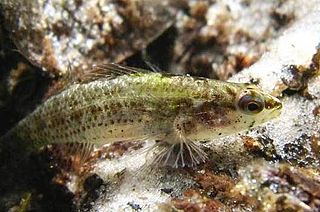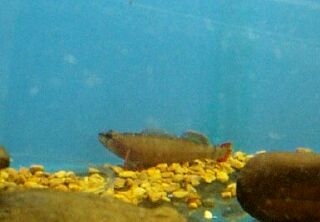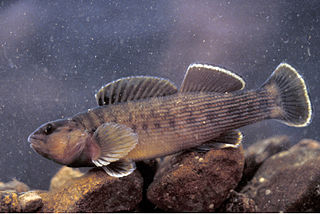
The Okaloosa darter is a species of freshwater ray-finned fish, a darter from the subfamily Etheostomatinae, part of the family Percidae, which also contains the perches, ruffes and pikeperches. It is indigenous to freshwater streams and tributary systems in Okaloosa and Walton Counties in northwest Florida.

The yellowcheek darter is a species of freshwater ray-finned fish, a darter from the subfamily Etheostomatinae, part of the family Percidae, which also contains the perches, ruffes and pikeperches. It is endemic to the eastern United States where it is only known to occur in the state of Arkansas in the Little Red River. It inhabits medium-sized and smaller rivers in rocky riffles with strong current. This species can reach a length of 7.2 centimetres (2.8 in) TL though most only reach about 4.9 centimetres (1.9 in).
The Bayou darter is a rare species of freshwater ray-finned fish, a darter from the subfamily Etheostomatinae, part of the family Percidae, which also contains the perches, ruffes and pikeperches. It is endemic to western Mississippi in the United States, where it is found only in the Bayou Pierre River and its tributaries. Its typical habitat is fast-flowing creeks and streams, in riffles and in areas between riffles with firm gravel bottoms. It feeds on small insects and their larvae. Breeding probably takes place twice a year, in spring and late summer. The population of this fish is declining due to loss of suitable habitat. This is caused by siltation and pollution, particularly erosion caused by changes in land use. The International Union for Conservation of Nature has assessed its conservation status as being "endangered".

The boulder darter species of freshwater ray-finned fish, a darter from the subfamily Etheostomatinae, part of the family Percidae, which also contains the perches, ruffes and pikeperches. It is endemic to Alabama and Tennessee in the United States, where it occurs in the Elk River system and Shoal Creek. It is found in small rivers and fast-flowing streams, at least 2 ft (0.6 m) deep, with boulders or a rocky base. It feeds on aquatic insect larvae but little is known of its natural history. The population trend of this fish is unknown but it is affected by a rise in siltation and the impoundment of water within its range by the building of dams. The International Union for Conservation of Nature has assessed its conservation status as being "vulnerable".

The oyster mussel is a rare species of freshwater mussel in the family Unionidae. This aquatic bivalve mollusk is native to the Cumberland and Tennessee River systems of Kentucky, Tennessee, Alabama, and Virginia in the United States. It has been extirpated from the states of Georgia and North Carolina. It is a federally listed endangered species of the United States.
The triangular kidneyshell is a species of freshwater mussel, in the family Unionidae, the river mussels. It is endemic to Alabama in the United States, where it is known from several rivers and streams in the Mobile River Basin. It is a federally listed endangered species of the United States.

The bluemask darter is a species of freshwater ray-finned fish, a darter from the subfamily Etheostomatinae, part of the family Percidae, which also contains the perches, ruffes and pikeperches. It is endemic to the eastern United States. It is a federally listed endangered species of the United States. This fish was not formally described until 2009, but it was added to the US Endangered Species List in 1993. During breeding, the male has bright blue patches on its head and other areas. This fish is found only in the Caney Fork River system, a tributary of the Cumberland River in Tennessee. The species name akatulo comes from the Cherokee for "mask", referring to the solid blue coloration on the lower face of the fish.
The Cumberland snubnose darter is a species of freshwater ray-finned fish, a darter from the subfamily Etheostomatinae, part of the family Percidae, which also contains the perches, ruffes and pikeperches. This species is found it the middle Cumberland River drainage in Tennessee, Kentucky, Virginia, North Carolina, Georgia, and Alabama. It is absent in reaches above the Big South Fork, rare in North Carolina, and absent in western tributaries of the Tennessee River. While research on the ecology of E. atripinne is not extensive, what is known is they are usually found in small to medium freshwater streams in gravel riffle areas where their eggs can attach to the substrate and be left unguarded. E. atripinne can be found within a wide range of depths in its environment, leading its being classified as benthopelagic. While its global status is secure, the American Fisheries Society labels it with a status of “Special Concern”.

The bluebreast darter is a small species of freshwater ray-finned fish, a darter from the subfamily Etheostomatinae, part of the family Percidae, which also contains the perches, ruffes and pikeperches. It is endemic to the eastern United States from New York and Illinois to Tennessee and North Carolina.
The tuxedo darter is a species of freshwater ray-finned fish, a darter from the subfamily Etheostomatinae, part of the family Percidae, which also contains the perches, ruffes and pikeperches. It is endemic to the Southeast United States in the Cumberland River system.
The goldstripe darter is a species of freshwater ray-finned fish, a darter from the subfamily Etheostomatinae, part of the family Percidae, which also contains the perches, ruffes and pikeperches. It is endemic to the southeastern United States where it is found in Gulf Slope streams from the Colorado River drainage in Texas to the Flint River in Georgia, the Atlantic Slope in Ocmulgee River system, Georgia, and the Mississippi embayment north as far as southeastern Missouri and western Kentucky. It is typically found in small springs, streams, and creeks with aquatic and marginal vegetation and detritus. The female spawns on multiple occasions between about mid-March and June, sticking the adhesive eggs to plants, gravel and the sides of rocks. The goldstripe darter is a common species with a wide range and numerous sub-populations, and the International Union for Conservation of Nature has assessed its conservation status as being of "least concern".
The Citico darter is a threatened species freshwater ray-finned fish, a darter from the subfamily Etheostomatinae, part of the family Percidae, which also contains the perches, ruffes and pikeperches. It is native to Tennessee. This species was formerly subsumed within Etheostoma percnurum. The E. percnurum group now consists of four distinct species: E. percnurum, E. marmorpinnum, E. lemniscatum, and E. sitikuense.

The Swannanoa darter is a species of freshwater ray-finned fish, a darter from the subfamily Etheostomatinae, part of the family Percidae, which also contains the perches, ruffes and pikeperches. It is endemic to the eastern United States where it occurs in the drainage of the Tennessee River. It prefers flowing water in riffles in cool, clear mountain streams, with boulder substrates. The diet and natural history of this species have been little studied but are probably similar to those of its close relative, the greenside darter. The population trend of this fish seems to be stable and it is a common species with numerous sub-populations over its limited range, and the International Union for Conservation of Nature has assessed its conservation status as being of "least concern".

The gilt darter is a species of freshwater ray-finned fish, a darter from the subfamily Etheostomatinae, part of the family Percidae, which also contains the perches, ruffes and pikeperches. It can be found in a number of states in the Mississippi River drainage of the United States although it has been extirpated from some river systems in which it was at one time present, mostly due to siltation and pollution problems. Males are more colorful than females and can grow to a length of about 9 cm (3.5 in). It is a benthic fish that feeds primarily on small aquatic insect larvae. Males form territories during the breeding season in late spring and early summer. Spawning typically takes place at the upper ends of riffles with sandy and gravelly bottoms interspersed with larger cobbles. Some organisations are endeavouring to conserve populations of the gilt darter and re-introduce it to states where the fish has been extirpated but suitable habitat still exists.

The Cherokee darter is a rare species of freshwater ray-finned fish, a darter from the subfamily Etheostomatinae, part of the family Percidae, which also contains the perches, ruffes and pikeperches. It is endemic to Georgia in the United States, where it is limited to the Etowah River system. It inhabits creeks with rocky bottoms and little silt, typically occurring just above and below riffles. It is a whitish or yellowish fish with green and black spots on the flanks and eight dark saddle-like bars dorsally. It has a small range and its habitat is being degraded and fragmented, and the International Union for Conservation of Nature has assessed its conservation status as being endangered.
The Cumberland darter is a rare species of freshwater ray-finned fish, a darter from the subfamily Etheostomatinae, part of the family Percidae, which also contains the perches, ruffes and pikeperches. It is endemic to Kentucky and Tennessee in the United States, where it occurs in the upper Cumberland River tributaries above Cumberland Falls. It was federally listed as an endangered species in the US on August 9, 2011.

Etheostoma etowahae, the Etowah darter, is a species of freshwater ray-finned fish, a darter from the subfamily Etheostomatinae, part of the family Percidae, which also contains the perches, ruffes and pikeperches. It is a rare species which is endemic to Georgia in the United States, where it occurs only in the Etowah River and two of its tributaries. It is a federally listed vulnerable species of the United States.

The relict darter is a rare species of freshwater ray-finned fish, a darter from the subfamily Etheostomatinae, part of the family Percidae, which also contains the perches, ruffes and pikeperches. It is endemic to Kentucky, where it occurs only in the drainage of the Bayou du Chien. It is a federally listed endangered species of the United States.
The rush darter is a rare species of freshwater ray-finned fish, a darter from the subfamily Etheostomatinae, part of the family Percidae, which also contains the perches, ruffes and pikeperches. It is endemic to Alabama in the United States, where it occurs in three river systems. It was federally listed as an endangered species of the United States on August 9, 2011.

Nothonotus is a genus or subgenus of freshwater ray-finned fish, a darter from the subfamily Etheostomatinae, part of the family Percidae, which also contains the perches, ruffes and pikeperches. It is endemic to the southeastern United States. First proposed as a sub-genus of Etheostoma in 1988, there is still debate regarding the appropriate taxonomic rank of Nothonotus in the literature. Darter species comprise more than 180 of the Percidae taxa.













